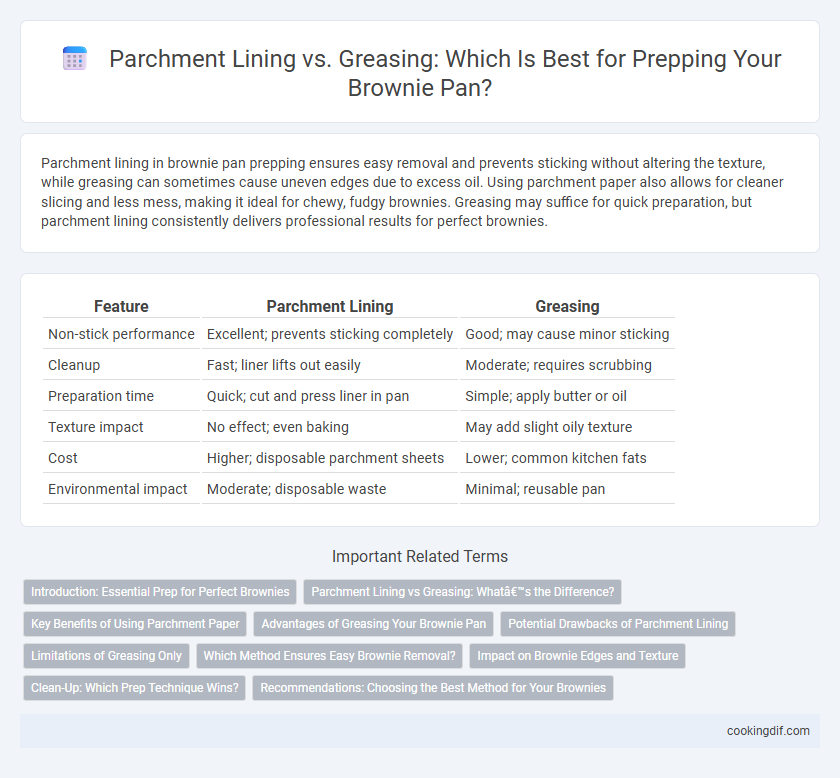Parchment lining in brownie pan prepping ensures easy removal and prevents sticking without altering the texture, while greasing can sometimes cause uneven edges due to excess oil. Using parchment paper also allows for cleaner slicing and less mess, making it ideal for chewy, fudgy brownies. Greasing may suffice for quick preparation, but parchment lining consistently delivers professional results for perfect brownies.
Table of Comparison
| Feature | Parchment Lining | Greasing |
|---|---|---|
| Non-stick performance | Excellent; prevents sticking completely | Good; may cause minor sticking |
| Cleanup | Fast; liner lifts out easily | Moderate; requires scrubbing |
| Preparation time | Quick; cut and press liner in pan | Simple; apply butter or oil |
| Texture impact | No effect; even baking | May add slight oily texture |
| Cost | Higher; disposable parchment sheets | Lower; common kitchen fats |
| Environmental impact | Moderate; disposable waste | Minimal; reusable pan |
Introduction: Essential Prep for Perfect Brownies
Using parchment lining for brownie pans ensures easy removal and prevents sticking, maintaining the brownie's texture without added fats. Greasing the pan provides a quick, effective barrier but may result in slightly denser edges due to oil absorbance. Choosing parchment paper enhances clean cleanup and preserves the fudgy interior crucial for perfectly baked brownies.
Parchment Lining vs Greasing: What’s the Difference?
Parchment lining creates a non-stick barrier that ensures brownies release cleanly from the pan without altering texture, while greasing coats the pan with fat, which can sometimes cause uneven browning or affect edges. Parchment paper is preferred for its ease of removal and minimal impact on taste, especially in dense or fudgy brownie recipes. Greasing is quicker but may require flour dusting for better release, making parchment lining the superior method for consistent brownie pan prepping.
Key Benefits of Using Parchment Paper
Using parchment paper to line a brownie pan ensures even baking by preventing sticking and promoting consistent heat distribution. It simplifies cleanup by creating a non-stick barrier that allows brownies to lift out easily without breaking. Parchment also supports healthier baking by reducing the need for excess grease or butter, preserving the intended texture and flavor of the brownies.
Advantages of Greasing Your Brownie Pan
Greasing your brownie pan creates a non-stick surface that ensures easy removal without tearing, preserving the perfect texture and shape of each brownie. Using butter or oil for greasing adds a slight richness and enhances the crust's flavor, contributing to a more enjoyable taste experience. Greasing requires less prep time and materials than parchment lining, making it a convenient and efficient choice for quick baking sessions.
Potential Drawbacks of Parchment Lining
Parchment lining in brownie pans can lead to uneven heat distribution, potentially causing inconsistent baking and texture. The paper may also tear or shift during batter pouring, resulting in spillage or difficulty removing brownies cleanly. Unlike greasing, parchment lacks fat, which can affect the crust's crispness and overall brownie top formation.
Limitations of Greasing Only
Greasing a brownie pan alone can lead to uneven cooking and difficulty removing the brownies cleanly, increasing the risk of tearing or sticking. This method often fails to provide a consistent barrier between the batter and pan, especially in corners, causing parts to stick and complicate cleanup. Without parchment lining, greasing may also result in excess oil pooling at the bottom, altering the texture and taste of the final product.
Which Method Ensures Easy Brownie Removal?
Parchment lining ensures easy brownie removal by creating a non-stick surface that prevents sticking and allows brownies to lift out cleanly without breaking. Greasing the pan can help, but may result in uneven coating or partial sticking, making it harder to remove brownies intact. For consistent and effortless removal, parchment paper is the preferred method in brownie pan prepping.
Impact on Brownie Edges and Texture
Parchment lining creates a barrier that prevents brownies from sticking and promotes even baking, resulting in clean, well-defined edges with a soft, fudgy texture. Greasing the pan can lead to slightly crispier edges due to direct contact with the fat but may cause uneven browning or risk sticking if not applied evenly. For uniform texture and easy removal, parchment lining is preferred, while greasing offers a richer edge crust favored by some bakers.
Clean-Up: Which Prep Technique Wins?
Parchment lining for brownie pan prepping significantly simplifies clean-up by preventing batter from sticking, allowing for easy lift-out and minimal residue. Greasing the pan often leaves oily buildup and can cause stubborn brownie bits to cling, requiring scrubbing. For quick, mess-free clean-up, parchment lining is the superior choice.
Recommendations: Choosing the Best Method for Your Brownies
Parchment lining is recommended for brownies that require easy removal and clean edges, as it prevents sticking and simplifies cleanup. Greasing the pan works best for recipes with high fat content or when a crispier crust is desired, offering a richer texture. For optimal results, choose parchment for fudgy brownies and greasing for cakier varieties to enhance both texture and presentation.
Parchment lining vs Greasing for brownie pan prepping Infographic

 cookingdif.com
cookingdif.com